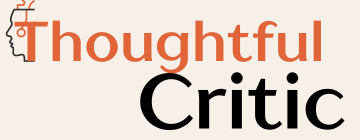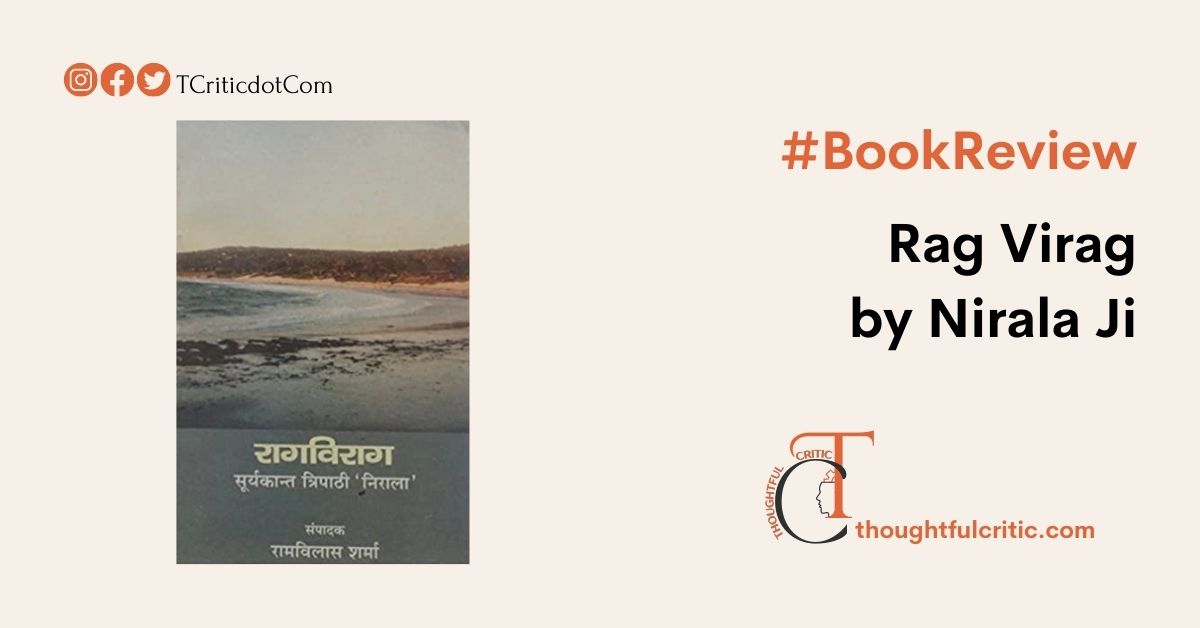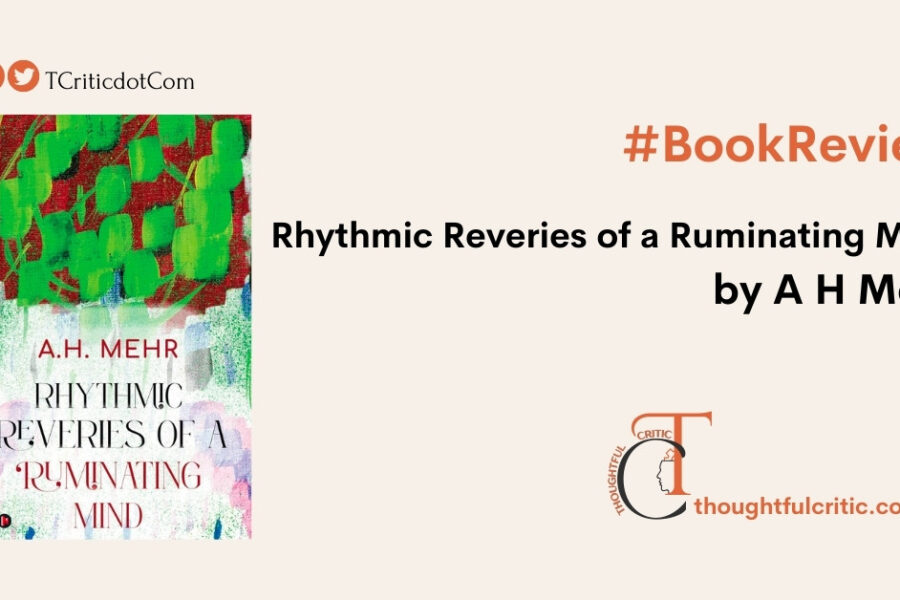Suryakant Tripathi Nirala, a poet whom almost every reader of Hindi poetry reveres this or that way, was a landmark that still continues to illuminate the new poets and authors writing in Hindi. With the high standards that he set for poetry in Hindi, Nirala’s art of writing poetry developed from narrow lanes of self-search to the broad path of inner peace, religious solace, and spiritual union with God and the art itself. There are many collections of poems that he published in his lifetime and many keep occurring even after his demise, many decades ago. Nirala was a phenomenon, and he is destined to remain a golden shadow lingering through the pages of the history of Hindi poetry… for a long time to come… and perhaps forever because there will always be some genuine readers of poetry who can distinguish between the genuine art and deception with words. In this book review article, I will be reviewing the poetry collection Rag Virag by Nirala.
Raag Virag! What a book! Amazing, wonderful, mind-blowing, fantastic, remarkable, magnificent, spellbinding and all other adjectives together cannot define the beauty and depth of poems by Suryakant Tripathi Nirala. One of the popular poets of the Chayavad movement in Hindi literature, Nirala’s Rag Virag is a real masterpiece. I am not sure whether I will be able to do justice to his poems by writing this review as you need to have a deep love for poetry and an insightful mind to understand the poems of Nirala. However, I will surely try to share my opinions. I read every poem in this collection many times. And today, I finally gather the courage to write my thoughts about Raag-Virag. This book is not only close to my heart but has become a part of my life. And you won’t believe every time I read these poems, they appear new and unique to me. This collection is like a prism from those middle school science laboratories. You put in your efforts and read a poem… and you get many thoughts that scatter on that side of your reading!
Like his pen name Nirala which actually means Unique, Suryakant Tripathi’s poems are unique. And anything unique quickly captures attention. They are full of imagery, emotions, metaphors and symbols. And the most interesting side of all his poems is that they are timeless and live. Like our scriptures, the poems of Nirala should be preserved, read and taught forever. As his poems are not just poems. They are beyond the limitations of being called merely literary works! If you follow the writings collected in Rag Virag, you may notice a journey of the poet’s consciousness. As I mentioned in the beginning, from self to the universal conscious! They are real lessons which everybody should learn and understand. Albeit, these lessons are shared with the magnificent beauty of poetic alibis and tools. After reading Nirala’s poems, I am pretty sure that our literature will always be indebted to him.
First published in the late 1920s, Raag-Virag meticulously reflects imagery, emotions and different facets of life – the poet’s and everybody else’s. Obviously, this book is a reflection of Nirala’s personal experiences and his observations of society. However, this book is a life guide for every reader. It is difficult to understand the poet’s true intentions and perspectives just by reading poems. But this book is like a “Geeta” to comprehend human conditions. Before discussing the book and poems, I would first focus on the title of the book – Ra(a)g Virag. The most simple definition, rather than a word, that defines Raag is Melody. Melody in life comes with love and passion. Love and passion are followed by anger and frustration. This eventually leads to attachment. And Attachment is the cause of all the pain and suffering in life. Now, comes the second part of the title which is Virag. If we translate Virag into English it means Dispassion. It is the state of hopelessness when you actually do not have anything to lose. Because there is nothing which you can own forever. Everything is fleeting. When you understand and accept this very thought, a sense of detachment develops in you. With detachment comes peace, contentment and happiness. This sentiment is echoed throughout the collection, and it is clear that Nirala was deeply influenced by the spiritual teachings of the Bhagavad Gita and other Hindu scriptures.
Raag-Virag is a journey from attachment to detachment, from love to spirituality. The prominent theme in the poems is love, both romantic and spiritual. Nirala’s treatment of love, unlike many other stalwarts of Hindi poetry from the Chhayavadi movement, is nuanced and complex, and he explores the different facets of this emotion with great sensitivity. Many readers may also notice Nirala’s poems are also marked by a deep sense of melancholy and longing (for something, someone or some missing part of the human soul). He writes about the emptiness and alienation that people experience in modern society, and how this can lead to a sense of despair.
Raag-Virag is not only a collection of poems, rather it is a full-size picture of the society (comprising of ups and downs) which he has painted through his words. The poems are characterized by their intricate use of language, vivid imagery, metaphors and symbols. Talking about the poetic diction of the great Hindi poet, Nirala’s choice of words is exquisite, and he skillfully weaves together Hindi and Braj Bhasha to create a unique and powerful poetic style. Once in a blue moon, you may also notice one or two Urdu-Farsi words used in his poems. Nirala was focused and dedicated to the use of the Hindi language that smells of the Sanskrit heritage. Each poem captures the essence of the emotions and experiences he portrays. For instance – Todati Patthar, a very popular poem of Nirala, in this particular poem Nirala has portrayed the struggle of a woman who is breaking stones in the scorching sun to earn a livelihood.
Her helplessness and her pain hit him hard. Through this woman, he has tried to highlight the state of the labour class of society. Badal Raag is another famous poem of Nirala in which he showcased how capitalists terrorize the poor and always exploit them. But when a revolution arises, capitalists are the one who is in fear of losing everything. Like the flood destroys everything in its flow, they have lost their peace in the flow of desires of getting more and more. While the lower class or downtrodden gets their rights through revolution. In destruction, they see new life, new happiness.
Another poem that resembles the solace of the Hindu philosophy and spiritual treasure is Maran Drishya (the sight of death) – मरण-दृश्य in Hindi. I am quoting the last two lines from the poem that covers the essence of the whole poem. Don’t fear death… it hasn’t come to kill you. It has rather come to set you free, free from the Maya of the world.
“मुक्ति हूँ मैं, मृत्यु में
आई हुई, न डरो !”
The poem ends in a peaceful way. However, it begins with a tone that celebrates life and inspires others to do the same. Nirala Ji writes:
कहा जो न, कहो !
नित्य – नूतन, प्राण, अपने
गान रच-रच दो !
In simple words, life is about living and doing things one loves. This life, after all, is a debt that should be paid once the time has come. The words, the style, and the free-flowing nature of these lines quoted above are amazing. The poet begins the lines of the poem about the sight of death with the fervour to lead life with zeal… it is ironically unique, brave and rather stunning!
And how can one forget the golden signature of the Hindi poetry – Ram Ki Shakti Puja – राम की शक्ति पूजा – a poem that decorates this collection. Written in magnificent Vira Rasa, something that no other poet could touch, Nirala’s poem is astonishingly worded, and I bet any reader would be successful in reading this poem only after a few attempts, at least 10-12 to be close to it. Here is an extract from the timeless, energetic, historic and eternally new poem:
…
बोले विश्वस्त कण्ठ से जाम्बवान-“रघुवर,
विचलित होने का नहीं देखता मैं कारण,
हे पुरुषसिंह, तुम भी यह शक्ति करो धारण,
आराधन का दृढ़ आराधन से दो उत्तर,
तुम वरो विजय संयत प्राणों से प्राणों पर।
रावण अशुद्ध होकर भी यदि कर सकता त्रस्त
तो निश्चय तुम हो सिद्ध करोगे उसे ध्वस्त,
शक्ति की करो मौलिक कल्पना, करो पूजन।
छोड़ दो समर जब तक न सिद्धि हो, रघुनन्दन!
तब तक लक्ष्मण हैं महावाहिनी के नायक,
मध्य भाग में अंगद, दक्षिण-श्वेत सहायक।
मैं, भल्ल सैन्य, हैं वाम पार्श्व में हनुमान,
नल, नील और छोटे कपिगण, उनके प्रधान।
सुग्रीव, विभीषण, अन्य यथुपति यथासमय
आयेंगे रक्षा हेतु जहाँ भी होगा भय।”
In the extract, you can find the legendary Jambvan Ji pacifying, suggesting and advising Sri Ram to do Shakti-puja and request the Adi Shakti, Jagdamba, for her blessings in order to win the war against adharm, Ravan. Look at the rhythmic movements in the lines and the use of words that are very close to the concerns, actions, ideas and emotions reflected by the characters mentioned in the poems. Though all the poetry by Nirala I have read, I have seldom found another match, this one is uniquely unique!
The poems in this collection are written in different forms, including sonnets and free verse. This diversity of forms adds to the depth and range of the collection, making it a joy to read. For example, Ram Ki Shakti Pooja is a narrative poem. This poem is inspired by the Bangla version of Ramayan. Instead of the Ram-Ravan battle, through this poem, Nirala has focused on the freedom of Mata Sita who was imprisoned by Ravan. Another interpretation of this poem could be that it was to inspire people to fight for freedom from Britishers and in the present time it motivates us to conquer our fears to be successful.
You can get a copy of this amazing poetry collection from a bookstore near you or get a copy from Amazon India by clicking the link below:
Buy a copy of Rag Virag now – click here to go to the Amazon India book page.
By Parakashtha for ThoughtfulCritic
Rag Virag by Suryakant Tripathi Nirala – Book Review
-
Thoughtful Critic's Rating
Summary
Rag Virag by Suryakant Tripathi Nirala is an amazing, historic, wonderful and a must-read collection of some of the immortal Hindi poems composed by this Sadhak of Kavya Shakti!


